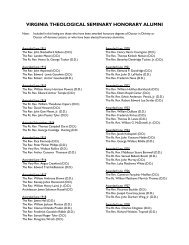Seminary Journal 2008 (August) - Virginia Theological Seminary
Seminary Journal 2008 (August) - Virginia Theological Seminary
Seminary Journal 2008 (August) - Virginia Theological Seminary
You also want an ePaper? Increase the reach of your titles
YUMPU automatically turns print PDFs into web optimized ePapers that Google loves.
serves. I am old enough to remember,<br />
back in the 1960s and 1970s, when the<br />
great fear was that the world would<br />
not be able to feed itself. Population<br />
would double in 30 years, but we<br />
asked how on Earth could food production<br />
double? The California biologist<br />
Paul Ehrlich wrote a book called<br />
The Population Bomb in which he said<br />
“the battle to feed the world is over…<br />
billions will die in the 1980s.”<br />
But it didn’t happen. The world’s<br />
population did double. But so did<br />
food production. Scientists came to<br />
the rescue. They produced a new<br />
generation of “high-yield” varieties<br />
of crops like rice and wheat that have<br />
kept the world fed. But it now turns<br />
out that those super-crops use much<br />
more water than the supposedly ineffi<br />
cient crops they replaced. So, while<br />
the world grows twice as much food<br />
as it did a generation ago on much<br />
the same amount of land, it takes<br />
three times as much water to do it.<br />
We thought we were going to run out<br />
of land to grow food. Instead, we are<br />
running out of water.<br />
Everywhere, agriculture is emptying<br />
the world’s rivers—with dramatic<br />
consequences for the world around. I<br />
stood on the banks of the Rio Grande<br />
in Texas at a small town called Presidio,<br />
where the fi elds have been<br />
irrigated for more than 400 years,<br />
probably longer than anywhere else<br />
in the U.S. Now farmers are going<br />
bankrupt and the fi elds are returning<br />
to brush because of over-abstraction<br />
by upstream irrigators of cotton and<br />
corn and alfalfa. There is no water left<br />
in the river.<br />
“While the world grows<br />
twice as much food as it<br />
did a generation ago on<br />
much the same amount<br />
of land, it takes three<br />
times as much water<br />
to do it. We thought we<br />
were going to run out of<br />
land to grow food.<br />
Instead, we are running<br />
out of water.”<br />
You won’t spot this in any atlases but,<br />
in fact, the mighty Rio Grande is now<br />
two rivers. The main U.S. arm, rushing<br />
out of the Rockies, gives out 600 miles<br />
from the Gulf of Mexico. Its bed is<br />
then dry for nearly 200 miles until it is<br />
replenished from Mexico. Agriculture<br />
did this.<br />
I went to India, where British colonial<br />
engineers a century ago built the largest<br />
network of irrigation canals in the<br />
world to grow food and cotton for the<br />
empire. But today there is no water<br />
for many of those canals, because the<br />
rivers are dry for most of the year. Vir-<br />
tually the only water in India outside<br />
the short monsoon season is underground.<br />
Farmers have not sat back. Indian<br />
farmers are some of the most innovative<br />
in the world. In the past decade,<br />
more than 20 million of them have<br />
bought drills to tap that water, and<br />
cheap Yamaha pumps to bring it to the<br />
surface and water their crops.<br />
Thanks to this water, India, which<br />
40 years ago was a center of famine,<br />
feeds itself today, but at great cost. I<br />
visited villages where water tables<br />
were, until recently, only a few yards<br />
from the surface, but which are now<br />
hundreds of yards down. Farmers are<br />
taking from underground 24 cubic<br />
miles of water more every year than<br />
the rains replace.<br />
It’s hard to imagine a number like<br />
that, but Britain uses about 15 cubic<br />
kilometres of water a year for absolutely<br />
everything. So imagine that<br />
times six or seven. That’s not the total<br />
amount being pumped by the farmers,<br />
that’s the amount being pumped<br />
that is not being replaced by the<br />
monsoon rains.<br />
India’s green revolution is living on<br />
borrowed water and borrowed time.<br />
The crash will come, not everywhere<br />
at the same time, but inexorably nonetheless.<br />
And dozens of other countries<br />
are going the same way as the rivers<br />
run dry. For the fi rst time in its history,<br />
China—the world’s most populous<br />
country—can no longer feed itself, for<br />
lack of water.<br />
Water shortages are bringing lifethreatening<br />
confl icts, not least in<br />
the Middle East. I visited Palestinian<br />
towns and villages on the West<br />
62 VIRGINIA SEMINARY JOURNAL AUGUST 2007



